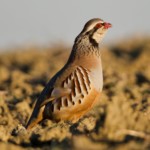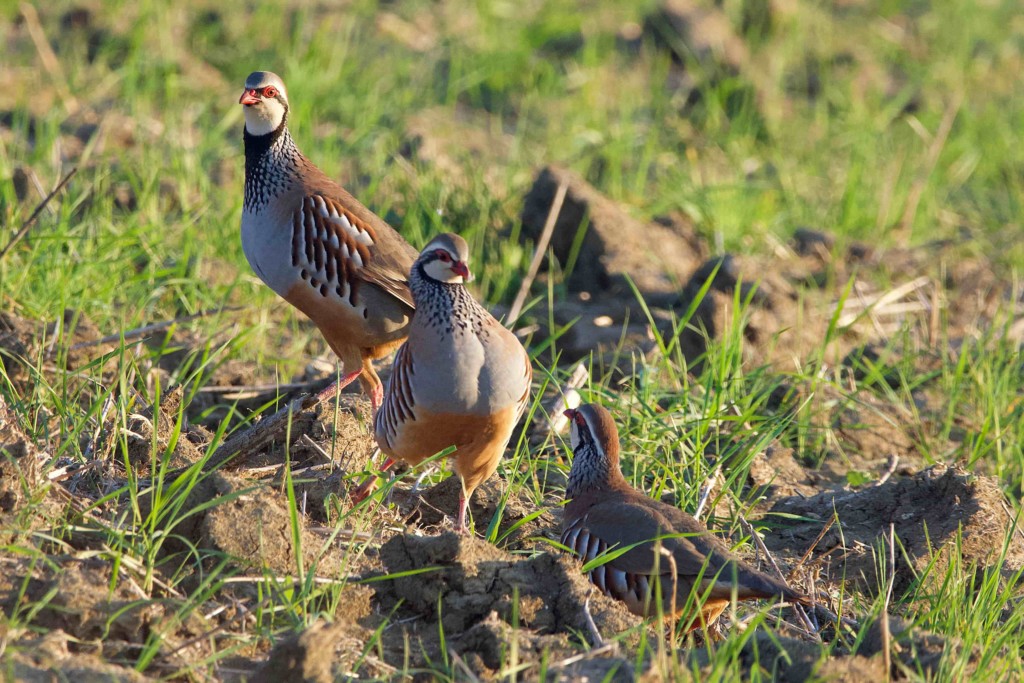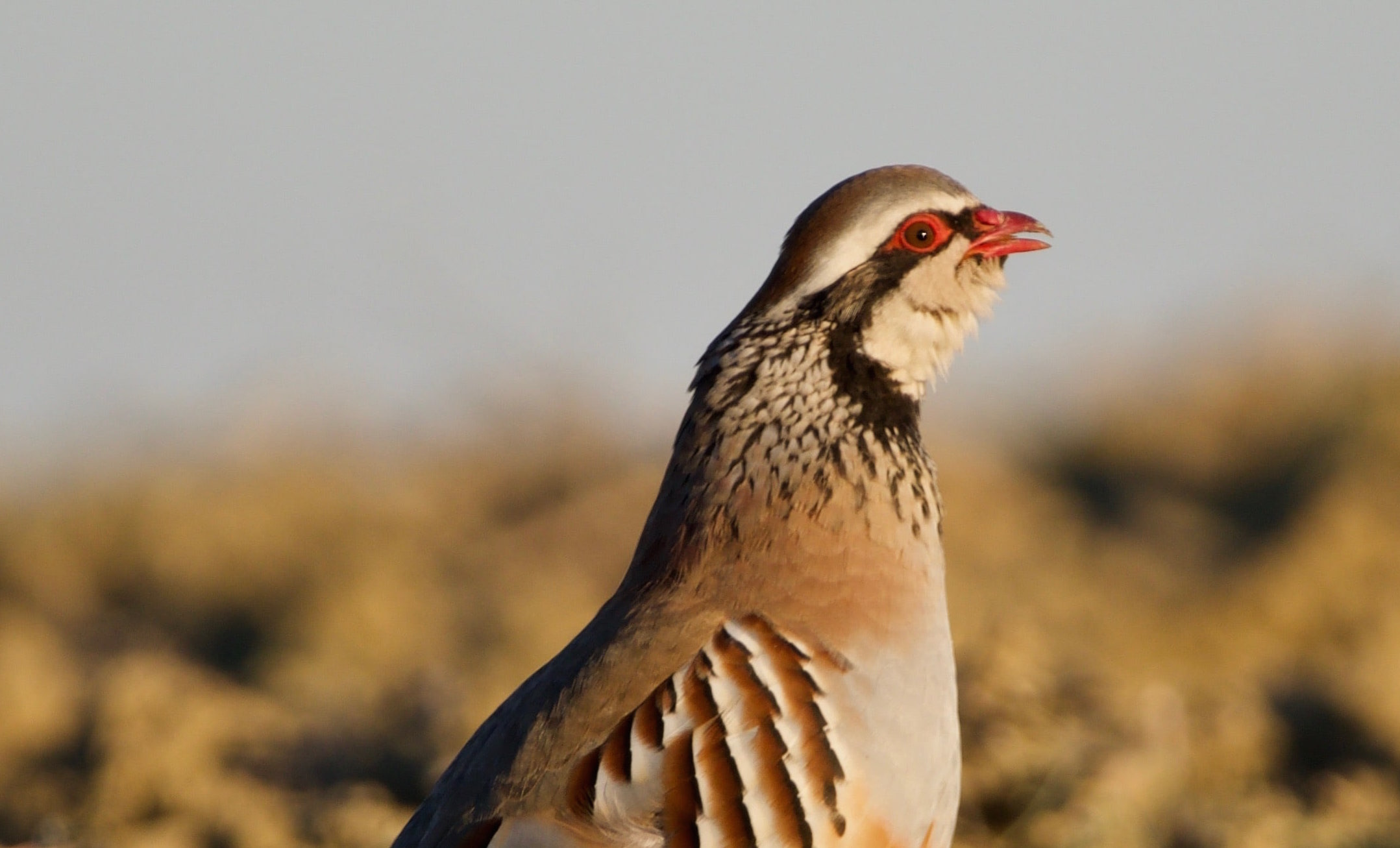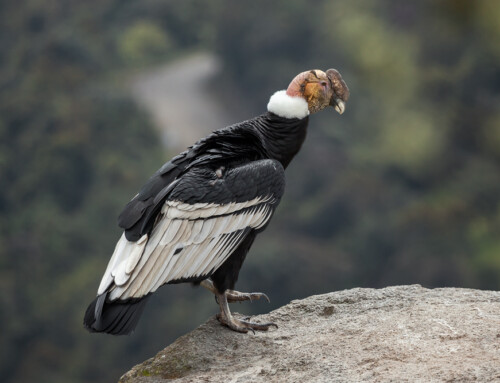LINKED PAPER
Genome-wide markers redeem the lost identity of a heavily managed gamebird. Forcina, G., Tang, Q., Cros., E., Guerrini, M., Rheindt, F.E. & Barbanera, F. 2021 Proceedings of the Royal Society Series B: Biological Sciences. DOI: 10.1098/rspb.2021.0285 VIEW
 The Red-legged Partridge (Alectoris rufa Linnaeus, 1758) is a medium-sized galliform occurring in southwestern Europe with two traditionally recognised subspecies ranging from the Iberian Peninsula (A. r. hispanica and A. r. intercedens in the North West and its remaining portion, respectively) and the nominate one across central and southern France to a portion of northwestern Italy. This species also inhabits the Balearics, Corsica, and part of the Tuscan Archipelago (Madge and McGowan 2002). Harvested and reared by millions every year for game purposes and meat production (Blanco-Aguiar et al. 2008), the Red-legged Partridge forms the base of several dishes of western Mediterranean regional gastronomy (Martinez-Carrasco et al. 2005) and is referred to as one of the most socioeconomically valuable gamebirds in Europe (Martínez-Fresno et al. 2008). This species has experienced a sharp global decline over the last decades due to habitat loss, pesticide use, agricultural mechanisation and overhunting (Vargas et al. 2006; Buenestado et al. 2009; Casas and Viñuela 2010; López-Antia et al. 2015). Already included in both the Habitat Directive and Bern Convention, the Red-legged Partridge qualifies as a Species of European Conservation Concern (category 2: BirdLife International 2004), and its conservation status has been upgraded (2020) to Near Threatened by the International Union for the Conservation of Nature and Natural Resources (see here).
The Red-legged Partridge (Alectoris rufa Linnaeus, 1758) is a medium-sized galliform occurring in southwestern Europe with two traditionally recognised subspecies ranging from the Iberian Peninsula (A. r. hispanica and A. r. intercedens in the North West and its remaining portion, respectively) and the nominate one across central and southern France to a portion of northwestern Italy. This species also inhabits the Balearics, Corsica, and part of the Tuscan Archipelago (Madge and McGowan 2002). Harvested and reared by millions every year for game purposes and meat production (Blanco-Aguiar et al. 2008), the Red-legged Partridge forms the base of several dishes of western Mediterranean regional gastronomy (Martinez-Carrasco et al. 2005) and is referred to as one of the most socioeconomically valuable gamebirds in Europe (Martínez-Fresno et al. 2008). This species has experienced a sharp global decline over the last decades due to habitat loss, pesticide use, agricultural mechanisation and overhunting (Vargas et al. 2006; Buenestado et al. 2009; Casas and Viñuela 2010; López-Antia et al. 2015). Already included in both the Habitat Directive and Bern Convention, the Red-legged Partridge qualifies as a Species of European Conservation Concern (category 2: BirdLife International 2004), and its conservation status has been upgraded (2020) to Near Threatened by the International Union for the Conservation of Nature and Natural Resources (see here).
 Figure 1 Red-legged Partridge females fighting for a male, Andalusia, Spain © Juan José Negro
Figure 1 Red-legged Partridge females fighting for a male, Andalusia, Spain © Juan José Negro
Starting from the second half of the last century onwards, the Red-legged Partridge has been increasingly suffering from human-mediated hybridisation with the Chukar Partridge (Alectoris chukar), a closely related species naturally ranging from Greece to China across a vast portion of the eastern Palaearctic (Negro et al. 2001; Baratti et al. 2004; Barbanera et al. 2009; Barilani et al. 2007; Guerrini and Barbanera 2009). The enactment of this practice, aimed at producing high numbers of captive-bred birds for restocking purposes and thus cutting the overall costs for both farmers and hunters, has been accompanied by the massive release of fertile hybrids (banned in the UK since the mid 1990s and in the countries falling within the species’ native range at the beginning of 2000s) into the wild. The latter, although less viable than their parental species, produce larger egg clutches which compensate this gap, and are hence able to establish and spread their gene introgression to native populations (Casas et al. 2012). To make things even worse, translocations irrespective of subspecies affinity have been carried out for decades, causing a widespread genetic homogenisation (sensu Olden and Rooney 2006), which possibly jeopardised even further the persistence of locally adapted genotypes, raising serious concern about the survival of native populations in the long run (Potts 1989, Barbanera et al. 2005, 2010; Rodríguez-García and Galián 2014).
Over the last two decades, the genetic consequences of this faunal reshuffling were unveiled in a number of studies employing single mitochondrial DNA loci (e.g. Forcina et al. 2020) and/or a limited number of microsatellite (e.g. Barbanera et al. 2011; Negri et al. 2013), Single Nucleotide Polymorphism (SNPs) (e.g. Sevane et al. 2010) and Random Amplified Polymorphic DNA loci (Negro et al. 2001; Barbanera et al. 2005, 2010, 2015). Specifically, these works have evidenced the occurrence of maternal A. chukar lineages across the entirety of the A. rufa range, including in the population introduced to the United Kingdom in the second half of the 18th century (Barbanera et al. 2015). Nevertheless, no genome-wide investigations to address the genetic structure and introgression issues had been carried out on this species until now.
 Figure 2 Left: Head of A. rufa (note the straw ear coverts and the streaked necklace): Right: head of A. chukar (note the bright reddish ear coverts and the continuous strongly demarcated necklace) © Filippo Barbanera
Figure 2 Left: Head of A. rufa (note the straw ear coverts and the streaked necklace): Right: head of A. chukar (note the bright reddish ear coverts and the continuous strongly demarcated necklace) © Filippo Barbanera
A study recently published in Proceedings of the Royal Society Series B and led by the University of Pisa (Italy), where the Red-legged Partridge is the focus of a well-established research line since the early 2000s, and the National University of Singapore (Singapore), has surprisingly evidenced that, when based on a robust dataset of genome-wide loci (>168.000 SNPs), the degree of A. chukar introgression within A. rufa populations was in reality way lower than expected, and the extent of this phenomenon varied greatly across the species’ range. Moreover, the Red-legged Partridge, characterised by a limited dispersal ability, turned out to display a still marked intraspecific genetic structure in contrast with that suggested by most previous studies. Specifically, in the eastern portion of the species’ range, A. r. rufa populations inhabiting Corsica turned out to be best preserved, while the western counterpart A. r. hispanica from Castilla-Léon and Asturias, in Spain, is the most genomically distinctive subspecies.
It is likely that previous estimates of introgression based on the comparatively low number of loci were inflated due to their location within “islands” of A. chukar DNA, while their inferential impact is negligible when a much larger portion of the A. rufa genome is taken into account. In other words, this suggests that the vast majority of the species’ gene pool (including adaptive loci as opposed to the neutral loci mostly used until now) has remained intact, possibly as a consequence of negative selection against maladaptive A. chukar traits (Casas et al. 2012). However, if previous claims about the loss of the species genomic uniqueness and its subspecies’ distinctiveness (Tejedor et al. 2007) were somehow too alarmist, this does not justify continuation of the thoughtless management (including the crossbreeding of captive stocks of different or even unknown geographic origin with the subsequent release of farm-reared individuals) that the Red-legged Partridge has been subjected to. Rather, these results tell us that we are still on time to preserve both the genomic identity and intraspecific structure of this iconic European species, and that current management practices should not ignore or disregard these recommendations.
An ongoing project involving the same partner institutions is aiming to produce the first genome assembly for the Red-legged Partridge, thus offering new insightful tools for studies addressing local adaptation and evolution in this species.
References
Baratti, M., Ammannati, M., Magnelli, C. & Dessì-Fulgheri, F. 2005. Introgression of chukar genes into a reintroduced red-legged partridge (Alectoris rufa) population in central Italy. Animal Genetics 36: 29-35. VIEW
Barbanera, F., Negro, J.J., Di Giuseppe, G., Bertoncini, F., Cappelli, F. & Dini, F. 2005. Analysis of the genetic structure of red-legged partridge (Alectoris rufa, Galliformes) populations by means of mitochondrial DNA and RAPD markers: a study from central Italy. Biological Conservation 122: 275-287. VIEW
Barbanera, F., Guerrini, M., Khan, A.A., Panayides, P., Hadjigerou, P., Sokos, C., Gombobaatar, S., Samadi, S., Khan, B.Y., Tofanelli, S., Paoli, G. & Dini, F. 2009. Human-mediated introgression of exotic chukar (Alectoris chukar, Galliformes) genes from East Asia into native Mediterranean partridges. Biological Invasions 11: 333-348. VIEW
Barbanera, F., Pergams, O.R.W., Guerrini, M., Forcina, G., Panayides, P. & Dini, F. 2010. Genetic consequences of intensive management in game birds. Biological Conservation 143: 1259-1268. VIEW
Barbanera, F., Forcina, G., Guerrini, M. & Dini, F. 2011. Molecular phylogeny and diversity of Corsican red-legged partridge: hybridization and management issues. Journal of Zoology 285: 56-65. VIEW
Barbanera, F., Forcina, G., Cappello, A., Guerrini, M., van Grouw, H. & Aebischer, N.J. 2015. Introductions over introductions: the genomic adulteration of an early genetically valuable alien species in the United Kingdom. Biological Invasions 17: 409-422. VIEW
Barilani, M., Bernard-Laurent, A., Mucci, N., Tabarroni, C., Kark, S., Garrido, J.P. & Randi, E. 2007. Hybridisation with introduced chukars (Alectoris chukar) threatens the gene pool integrity of native rock (A. graeca) and red-legged (A. rufa) partridge populations. Biological Conservation 137: 57-69. VIEW
BirdLife International. 2004. Birds in Europe: Population Estimates, Trends and Conservation Status. BirdLife Conservation Series vol. 12, pp. 1-374. Wageningen, The Netherlands: BirdLife International.
Blanco-Aguiar, J.A., Gonzalez-Jara, P., Ferrero, M.E., Sánchez-Barbudo, I., Virgós, E., Villafuerte, R. & Dávila, J.A. 2008. Assessment of game restocking contributions to anthropogenic hybridization: the case of the Iberian red-legged partridge. Animal Conservation 11: 535-545. VIEW
Buenestado, F.J., Ferreras, P., Blanco-Aguiar, J.A., Tortosa, F.S. & Villafuerte, R. 2009. Survival and causes of mortality among wild Red-legged Partridges Alectoris rufa in southern Spain: Implications for conservation. IBIS 151: 720-730. VIEW
Casas, F., Mougeot, F., Sánchez-Barbudo, I., Dávila, J.A. & Viñuela, J. 2012. Fitness consequences of anthropogenic hybridization in wild red-legged partridge (Alectoris rufa, Phasianidae) populations. Biological Invasions 14: 295-305. VIEW
Casas, F. & Viñuela, J. 2010. Agricultural practices or game management: which is the key to improve red-legged partridge nesting success in agricultural landscapes? Environmental Conservation 37:177-186. VIEW
Forcina, G., Guerrini, M. & Barbanera, F. 2020. Non-native and hybrid in a changing environment: conservation perspectives for the last Italian red-legged partridge (Alectoris rufa) population with long natural history. Zoology 138: 125740. VIEW
Guerrini, M. & Barbanera, F. 2009. Noninvasive genotyping of the red-legged partridge (Alectoris rufa, Phasianidae): Semi-nested PCR of mitochondrial DNA from feces. Biochemical Genetics 47: 873-883. VIEW
López-Antia, A., Ortiz-Santaliestra, M.E., García-de Blas, E., Camarero, P.R., Mougeot, F. & Mateo, R. 2015. Adverse effects of thiram-treated seed ingestion on the reproductive performance and the offspring immune function of the red-legged partridge. Environmental Toxicology and Chemistry 34: 1320-1329. VIEW
Madge, S. & McGowan, P. 2002. Pheasants, partridges and grouse. A and C Black Publishers Ltd. London, UK.
Martínez-Carrasco, C., Bernabé, A., Ortiz, J.M. & Alonso, F.D. 2005. Experimental toxoplasmosis in red-legged partridges (Alectoris rufa) fed Toxoplasma gondii oocysts. Veterinary Parasitology 130: 55-60. VIEW
Martínez-Fresno, M., Henriques-Gil, N. & Arana, P. 2008. Mitochondrial DNA sequence variability in red-legged partridge, Alectoris rufa, Spanish populations and the origins of genetic contamination from A. chukar. Conservation Genetics 9: 1223-1231. VIEW
Negri, A., Pellegrino, I., Mucci, N., Randi, E., Tizzani, P., Meneguz, P.G. & Malacarne, G. 2013. Mitochondrial DNA and microsatellite markers evidence a different pattern of hybridization in red-legged partridge (Alectoris rufa) populations from NW Italy. European Journal of Wildlife Research 59: 407-419. VIEW
Negro, J.J., Torres, M.J. & Godoy, J.A. 2001. RAPD analysis for detection and eradication of hybrid partridges (Alectoris rufa x A. graeca) in Spain. Biological Conservation 9: 19-24. VIEW
Olden J.D. & Rooney T.P. 2006. On defining and quantifying biotic homogenization. Global Ecology and Biogeography 15: 113-120.
Potts, G.R. 1989. The impact of releasing hybrid partridges on wild red-legged populations. Game Conservancy Annual Review 20: 81-85.
Rodríguez-García, M.J. & Galián, J. 2014. Lack of mitochondrial genetic structure in the red-legged partridge Alectoris rufa (Phasianidae). Journal of Zoological Systematics and Evolutionary Research 52: 59-64. VIEW
Sevane, N., Cortés, O., García, D., Cañón, J. & Dunner, S. 2010. New single nucleotide polymorphisms in Alectoris identified using chicken genome information allow Alectoris introgression detection. Molecular Ecology Resources 10: 205-213. VIEW
Vargas, J.M., Guerrero, J.C., Farfán, M.A., Barbosa, A.M. & Real, R. 2006. Land use and environmental factors affecting red-legged partridge (Alectoris rufa) hunting yields in southern Spain. European Journal of Wildlife Research 52:188-195. VIEW
Image credit
Top right: Red-legged Partridge Alectoris rufa emitting an alarm call, Andalusia, Spain. © Juan José Negro




